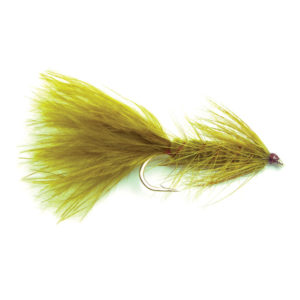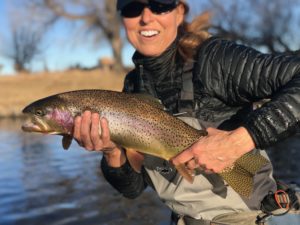 Fall is my favorite season of the year. It’s that perfect combination of jeans, a pullover sweater and flip flops. If I could dress like that everyday, I’d be forever content. It’s also an incredible time to fish as trout hunger for protein during long shadow days dressed in golden sunlight. The foliage is bursting with color and so are the fish. Fall fishing is simply a visual and sensory feast. It’s also a time when steamer fishing really turns on.
Fall is my favorite season of the year. It’s that perfect combination of jeans, a pullover sweater and flip flops. If I could dress like that everyday, I’d be forever content. It’s also an incredible time to fish as trout hunger for protein during long shadow days dressed in golden sunlight. The foliage is bursting with color and so are the fish. Fall fishing is simply a visual and sensory feast. It’s also a time when steamer fishing really turns on.
The extra weight of a fluffy streamer always feels good to me, and while throwing dry flies and watching the take is exciting, I prefer the surprise of an aggressive underwater slam from linebackers that don’t often expend the energy it takes to jump out of the water for a measly little mayfly. These heavyweights would rather sit strategically and wait to ambush prey like minnows, baitfish, leeches, crayfish, shrimp and drowning terrestrial insects. Quality over quantity for calories spent. It’s the same formula for most predatory creatures. They want bang for their buck.

Streamer fishing is hugely satisfying I think, because its so engaging. You cast and then have to work it: You’re stripping that fly fast or slow, using short or long strips, and all the time you’re working your fly, you’re also watching, and feeling for the slightest tick or tug to que you to set the hook. It’s what they call in the education field as, TPR: Total Physical Response, when all your senses are engaged. Whereas when fishing dry flies, the tendency is just to rely on visual input and ques. Streamer fishing requires the angler to use it all. Since the strip is center to this, it would seem so is a reel. So how does this all play out on a tenkara rod when there’s no reel in the picture? Can you streamer fish on tenkara? How do you strip without a reel?
You can streamer fish on tenkara rods and it’s more intrinsic than you imagine. After casting, instead of holding your tenkara rod tip up high, you hold it low, roughly 35-45 degrees off the surface of the water. Then, with the rod roughly parallel to the surface of the water and your arm in front of you, begin to move your wrist in a small flicking motion while slowly drawing your arm out to your side away from your chest, and finally behind you. These two movements of your wrist and your arm, in combination, mimic the the motion of a reel strip, by twitching the fly, while simultaneously progressing it through the water, to resemble a small fish or aquatic animal swimming. It’s as easy as that.
 For the sake of efficiency, as you near the end of your backward arm motion, begin to slowly raise your arm and rod tip, causing the line to lift out of the water. This motion water loads your line. With your final backwards motion, give an extra lift and flick of your wrist, with a definitive “stop” at the top which allows your rod to throw the line and let it extend out fully behind you. This then, sufficiently loads your rod to complete a back cast and allows you to immediately recast without wasted strokes or motion. It is highly effective, efficient and productive and creates a wonderful rhythm that’s graceful on the water – similar, but different than when casting a reel.
For the sake of efficiency, as you near the end of your backward arm motion, begin to slowly raise your arm and rod tip, causing the line to lift out of the water. This motion water loads your line. With your final backwards motion, give an extra lift and flick of your wrist, with a definitive “stop” at the top which allows your rod to throw the line and let it extend out fully behind you. This then, sufficiently loads your rod to complete a back cast and allows you to immediately recast without wasted strokes or motion. It is highly effective, efficient and productive and creates a wonderful rhythm that’s graceful on the water – similar, but different than when casting a reel.
The hookset is also very intrinsic because you’re arm and wrist are already in motion and moving in the desired direction during the strip, to set the hook. With a solid pop, you’re now wholly connected and since you’re working 35-45 degrees off the surface of the water, you’ll almost automatically in the “power curve” position where we fight and guide the fish in tenkara. From here, it boils down to fish management and what I refer to as “Fish Geometry” (that’s the next blog article). But the short of it is this: Do whatever is necessary to maintain the power curve – a broad, open, deep curve that equally distributes the pressure and load over the entire length of your tenkara rod. Fight from the side, not from overhead. Keep steady, constant pressure on the fish, and never ever let your rod straighten out in front or behind you. Straight rods are for runs when you have a reel -so we avoid this at all costs. In tenkara, straight rods essential equate to lost fish. Keep the curve, to keep the fish. From here, your landing techniques take over.

One last tidbit on streamer fishing on tenkara: Utilize the rod’s 360 degree flexibility. You’re not stuck casting on a single plane like you are with a rod and reel set up. Tenkara rods have no spine or belly and can flex in all directions. Sine you don’t have a reel, this allows you to throw from different directions or even cast with your less dominant hand. Try stripping in the opposite direction by crossing the front of your body. You’ll actually end up striping “backwards” and setting the hook with a forward motion – crazy to think about but possible with a tenkara rod. As always, the best thing to do is get out there, play and experiment. The extra weight of a streamer pattern provides great feedback for learning and those big boys that lurk in the deep, or hideout in the undercuts hit hard and aggressive, and practically hookset themselves. Finally, don’t forget to take a moment to look around to appreciate those fabulous fall colors and that nip in the air. Fall is fantastic and fishing makes it that much better.




Nice article Karen. I’ve never tied streamers but what you described is how I fished in Patagonia with a guide a few years ago. Might have to give streamers a shot.
Dave
I highly recommend it – just so much fun, and super effective so what’s not to like, LOL!
how about a video?
HI David and thanks for reading the article. YES! We are trying to produce more video to post to our YouTube Channel and this is one that is a priority. The technique can be sorta seen on the bonefish video from the Seychelles. But we hear you and agree…just always a challenge for small companies.
David you asked and I tried hard to deliver. My apology for the wind at the beginning of the video – it gets better as the video gets going. I hope you find this helpful:
https://youtu.be/mx3i1X1t_rE
https://youtu.be/mx3i1X1t_rE
There ya go…
Nice article. Good points to try. I’ve tried some wooly buggers and small clousers as well as some other swimming bugs with my Tenkara rod. I’ve had some success with the small Bass and Bluegill in our local pond.
Thanks David – and good for you for experimenting and trying some different stuff. It’s all about having fun – and catch a few fish too.
Karin: this is a wonderful post. I have looked for years for an on-line discussion of fishing streamers (especially woolybuggers) with tenkara rods, and this is the first one I have found that gave real information on how to do so. If you are able to make a video, it would also be a very welcome resource.
There is a video! I’ll confess, the audio could be improved but I believe you’ll still find it informative. Here’s a link to it on our Zen YouTube Channel:
https://youtu.be/mx3i1X1t_rE
Karin
Don’t know how I missed this. Great article! I never was much of a streamer fisherman (for trout) with a Western fly rod. But gonna give this a try with tenkara.
Thanks!
Dave
Thanks for reading Dave. It has become one of my favorite ways to fish for trout and has delivered high productivity. I really like how active and intentional it is. And the hits from fish are often very hard and aggressive. Fun!
Karin:
Came across this article during a search for info on Tenkara streamer fishing. This past weekend I attended the Tenkara Camp in the GSMNP:
https://www.facebook.com/events/1549958482069498/?active_tab=discussion
There was a clinic on this same topic using 390 cm rods and “repurposing” western fly fishing, weight forward, fly line. Thanks so much for the additional info.
You’re very welcome. Not too long along we were criticized for even considering streamers on tenkara – glad to know it’s becoming more widely accepted. We have a nice video on it too that we did about a year ago that many have enjoyed. If you are interested, here’s the link:
https://youtu.be/mx3i1X1t_rE
I love the idea of fishing streamers and clouser minnows for smallies here in wisconsin with my sago! Thanks for this article Karin!